Content
Thanks to the efforts of breeders, apricot ceases to be an exceptionally thermophilic crop, suitable for growing only in the southern regions of Russia. Modern hybrids grow and bear fruit stably in the regions of the middle lane, in Siberia and the Urals. The description of the New Jersey apricot variety, which combines unpretentiousness, endurance and excellent fruit qualities, should arouse the interest of gardeners living in different climatic zones.
Description of the variety
Apricot "New Jersey" - the result of American selection, bred in 1971. The hybrid inherited the best varietal qualities of its parents: resistance to unfavorable weather factors, early maturity, large fragrant fruits with a dessert taste.
The early ripe variety "New Jersey" is a tree 4-5 m high with a sparsely spreading crown. The leaf plates are bright green. The root system is strong, well-branched, not susceptible to root rot. Apricot is unpretentious to the soil, can grow on heavy, moist soils, withstands the close occurrence of groundwater. In the photo there is a New Jersey apricot tree during the fruiting period.
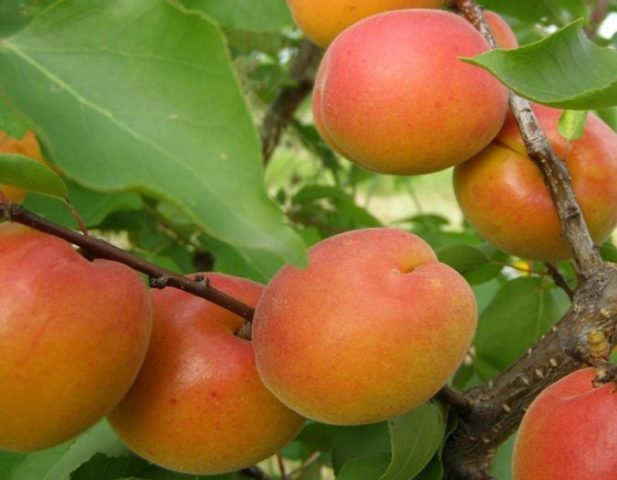
Variety "New Jersey" can be grown in waterlogged soil
The fruits of the hybrid are large, rounded, weighing 60-70 g, yellow, slightly pubescent, with a blurred blush on the sunny side. The stone is easily separated from the pulp, which has a medium juiciness in composition. The taste of the fruit is sweet, aromatic, with a slight sourness. Fruits tolerate long distance transportation well. The variety is prone to premature shedding of fruits. An indicator of the complete ripening of apricot is the easy separation of the skin from the pulp.
The New Jersey tree grown from seed bears smaller fruits, but is better adapted to the climatic conditions of cultivation. Apricots grafted on plums and cherry plums can be purchased at specialty stores and nurseries.
Characteristics
Apricot is large-fruited (a rare quality for an early variety), increased resistance to natural disasters. Thanks to the successful combination of varietal qualities, the New Jersey hybrid is suitable for growing in various regions of Russia, including the middle lane.
Drought tolerance, winter hardiness
The variety is characterized by increased drought resistance at the genetic level. The tree "New Jersey" has sufficient frost resistance - bark and shoots can withstand frosts down to -30 ˚С. Young plantings tend to dry out during prolonged thaws.
Pollination, flowering period and ripening times
Apricot "New Jersey" is a self-pollinated variety, capable of bearing fruit even with a single planting. To increase the yield, it is recommended to plant 2-3 trees of different varieties within a radius of 10-15 m.
The hybrid blooms early - in early April. Blooming flowers and young ovaries often suffer from recurrent frosts.Fruit ripening occurs depending on weather conditions: at the end of June or the first decade of July.
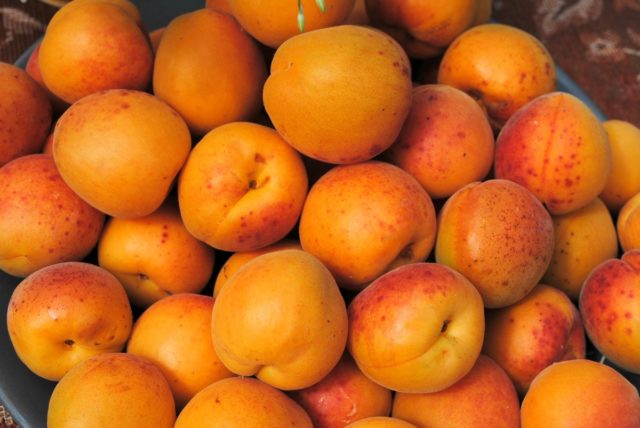
Good fruit set ensures abundant fruiting
Productivity, fruiting
New Jersey is a fast growing variety. The first apricots on a young tree appear in the second year. Stable, abundant fruiting begins at the age of 6-7 years. With good care, apricot has a high yield - one tree can produce up to 40-50 kg of fruit.
Scope of the fruit
The hybrid has versatility. It is great for fresh consumption. The dense pulp allows the New Jersey variety to be used for various canning methods: making stewed fruit and jam. Apricot is suitable for making jam, marmalade and marshmallow.
Disease and pest resistance
The New Jersey hybrid has a high immunity to many apricot diseases: bacterial spot, scab, root rot and viral pathologies. During rainy periods, apricot is often affected by moniliosis, in which there is a massive loss of fruits, and clotterosporia. The sweet fruit of the tree attracts moth caterpillars and weevils. In hot weather, aphids appear on young shoots.
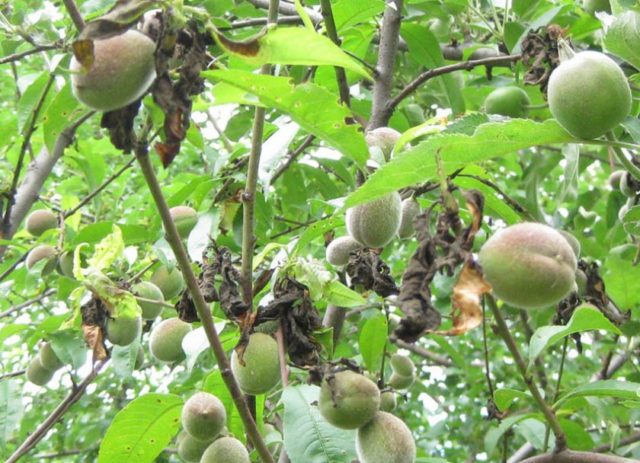
Lightning-fast development of moniliosis can lead to the death of the tree
Advantages and disadvantages
The New Jersey hybrid has many positive characteristics:
- early onset of fruiting, self-pollination;
- resistance to drought, high and low temperatures;
- excellent fruit set, high yield;
- large-fruited, excellent appearance and taste of fruits with a characteristic aroma;
- easy separation of the bone from the pulp;
- developed root system;
- unpretentiousness to growth on various soils, resistance to waterlogging of the soil;
- immunity to root rot disease;
- versatility of use, good transportability of fruits.
The negative qualities of the hybrid include a high susceptibility to moniliosis, forcing gardeners to harvest until fully ripe. In regions with a temperate climate, in cold weather, with early flowering, some flowers die.
Landing features
Cultivating an apricot tree requires certain skills. The main condition for an excellent harvest is the choice of a good seedling and the correct planting of the crop.
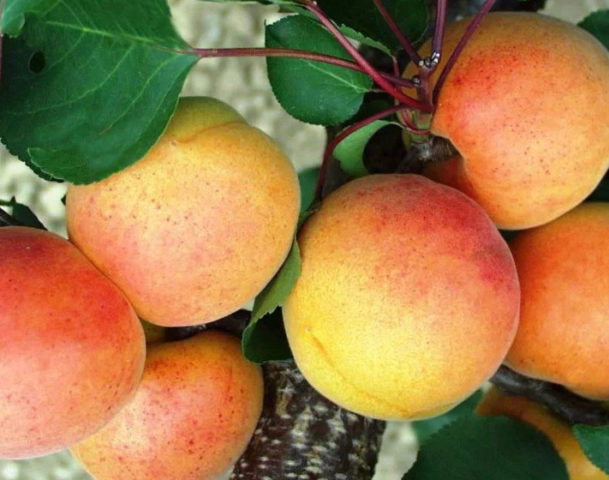
The fruit tree bears fruit annually subject to the rules of agricultural technology
Recommended timing
The New Jersey variety is planted in the southern regions mainly in the fall. In the middle lane, planting is possible in spring and autumn. In the Urals and Siberia, autumn frosts begin early, apricots are planted in spring.
Spring planting is carried out when the average daily temperature reaches + 5 ° C (in different regions, April or early May). In autumn, the apricot is planted a month before the onset of stable cold weather, so that the tree has time to take root.
Choosing the right place
The apricot is planted in a place where there is maximum light. The tree grows well near a wall or fence that protects the crop from winter winds and drafts. Southwest slopes and hills are suitable for planting. Despite the undemandingness of the New Jersey hybrid to the soil, the plant develops well in fertile air and permeable soils with low acidity.

The fruits of "New Jersey" should be harvested a little earlier than at the time of full ripening.
What crops can and cannot be planted next to an apricot
The apricot root system releases toxic substances. The neighborhood with a tree negatively affects the growth of apple and pear trees, stone fruits, berries and vegetable crops. It is recommended to plant fruit trees at a distance of at least 4 m from the apricot. In the near-stem circle of the plant, bulbous primroses look good: galanthus, crocuses, scillas.Marigolds, planted in summer, protect the fruit tree from insect pests.
Selection and preparation of planting material
2-3-year-old trees with a height of less than one and a half meters take root well in a new place. Saplings are chosen with the correct crown, long center conductor and a strong root system.
Before planting, the roots of the seedling are immersed in a clay mash for 4-5 hours. Damaged twigs and roots are cut off from trees, and wound surfaces are treated with garden pitch.
Landing algorithm
The planting hole is prepared at least a month before planting so that the soil is well compacted.
Step-by-step instruction:
- The top fertile soil is removed and set aside. Dig a planting hole 80 cm wide and deep.
- On clay soils, lowlands and places with groundwater, drainage is constructed from crushed stone or expanded clay 10-15 cm thick.
- A planting mixture is prepared, consisting of the top layer of fertile soil, compost and sand in equal proportions. Mineral fertilizers are added to the substrate and mixed thoroughly. Fill the planting hole, maintain a period of time for the disappearance of voids in the soil.
- The seedling is placed in the center, the root system is evenly distributed, a stake is stuck in and the plant is tied up. Sprinkle the soil until the root collar is 5 cm above the ground.
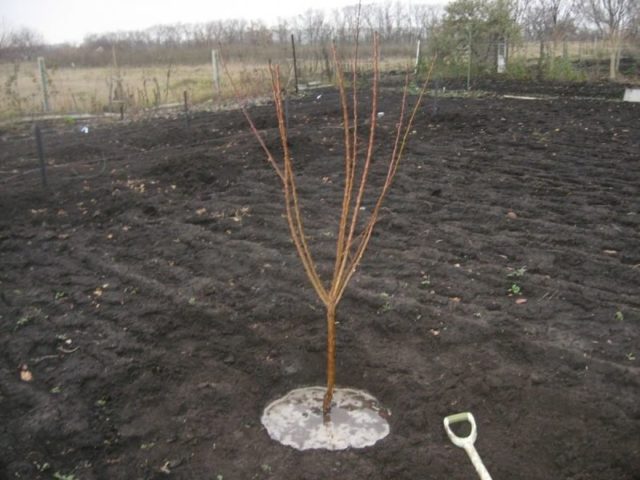
The trunk circle is slightly deepened for convenient watering
Follow-up care of the culture
Sanitary pruning of apricot is carried out in the spring, before the start of sap flow. At this time, the trees are fed with urea, in summer and autumn - with phosphorus-potassium fertilizers. Watering is carried out during dry periods, the last time is moistened at the end of August. After the end of the leaf fall, the plant residues are removed, the trunk circle is digged. Young seedlings are covered with spruce branches or lutrasil for the winter, and the lower part of the trunk is hilled.
Diseases and pests
"New Jersey" has low immunity to moniliosis - the most dangerous fungal pathology of apricot, affecting the aerial part of the tree and the root system. A lightning-fast development of the disease is possible - a molinous burn.
Typical signs:
- darkening and wilting of foliage;
- cracking of the bark, gum flow;
- wrinkling and shedding of fruits.
With the development of klyasternosporiosis, brown spots with a raspberry border appear on the leaves of "New Jersey". The leaf plates become perforated. The disease does not lead to the death of the tree, but weakens the plant and reduces the yield and presentation of the fruit.
The main pests of the tree:
- moth;
- black aphid;
- fruit weevil Goose;
- fruit striped moth.

The presence of disease weakens the New Jersey tree, causing the fruit to crumble
Conclusion
The description of the New Jersey apricot variety indicates that the hybrid has many positive qualities and minor disadvantages. An unpretentious drought-resistant and frost-resistant variety deserves the attention of experienced amateur gardeners and beginners, due to its high yield, early maturity and excellent quality of fruits, the ability to grow on different soils.
Reviews of New Jersey apricot varieties








